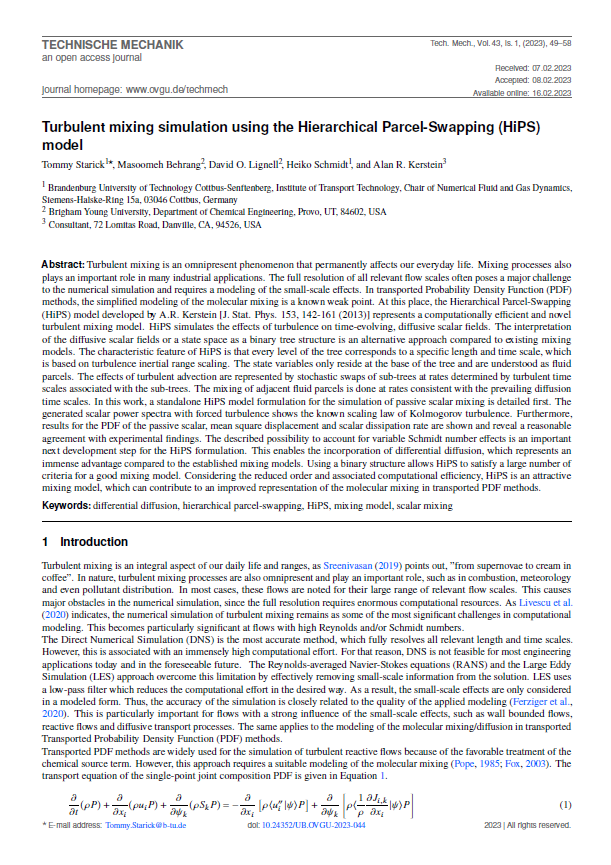Turbulent mixing simulation using the Hierarchical Parcel-Swapping (HiPS) model
DOI:
https://doi.org/10.24352/UB.OVGU-2023-044Keywords:
differential diffusion, hierarchical parcel-swapping, HiPS, mixing model, scalar mixingAbstract
Turbulent mixing is an omnipresent phenomenon that permanently affects our everyday life. Mixing processes also
plays an important role in many industrial applications. The full resolution of all relevant flow scales often poses a major challenge to the numerical simulation and requires a modeling of the small-scale effects. In transported Probability Density Function (PDF) methods, the simplified modeling of the molecular mixing is a known weak point. At this place, the Hierarchical Parcel-Swapping (HiPS) model developed by A.R. Kerstein [J. Stat. Phys. 153, 142-161 (2013)] represents a computationally efficient and novel turbulent mixing model. HiPS simulates the effects of turbulence on time-evolving, diffusive scalar fields. The interpretation of the diffusive scalar fields or a state space as a binary tree structure is an alternative approach compared to existing mixing models. The characteristic feature of HiPS is that every level of the tree corresponds to a specific length and time scale, which is based on turbulence inertial range scaling. The state variables only reside at the base of the tree and are understood as fluid parcels. The effects of turbulent advection are represented by stochastic swaps of sub-trees at rates determined by turbulent time scales associated with the sub-trees. The mixing of adjacent fluid parcels is done at rates consistent with the prevailing diffusion time scales. In this work, a standalone HiPS model formulation for the simulation of passive scalar mixing is detailed first. The generated scalar power spectra with forced turbulence shows the known scaling law of Kolmogorov turbulence. Furthermore, results for the PDF of the passive scalar, mean square displacement and scalar dissipation rate are shown and reveal a reasonable agreement with experimental findings. The described possibility to account for variable Schmidt number effects is an important next development step for the HiPS formulation. This enables the incorporation of differential diffusion, which represents an immense advantage compared to the established mixing models. Using a binary structure allows HiPS to satisfy a large number of criteria for a good mixing model. Considering the reduced order and associated computational efficiency, HiPS is an attractive mixing model, which can contribute to an improved representation of the molecular mixing in transported PDF methods.

Downloads
Published
How to Cite
Issue
Section
License
Copyright (c) 2023 Tommy Starick, Masoomeh Behrang, David O. Lignell, Heiko Schmidt, Alan R. Kerstein

This work is licensed under a Creative Commons Attribution-ShareAlike 4.0 International License.




